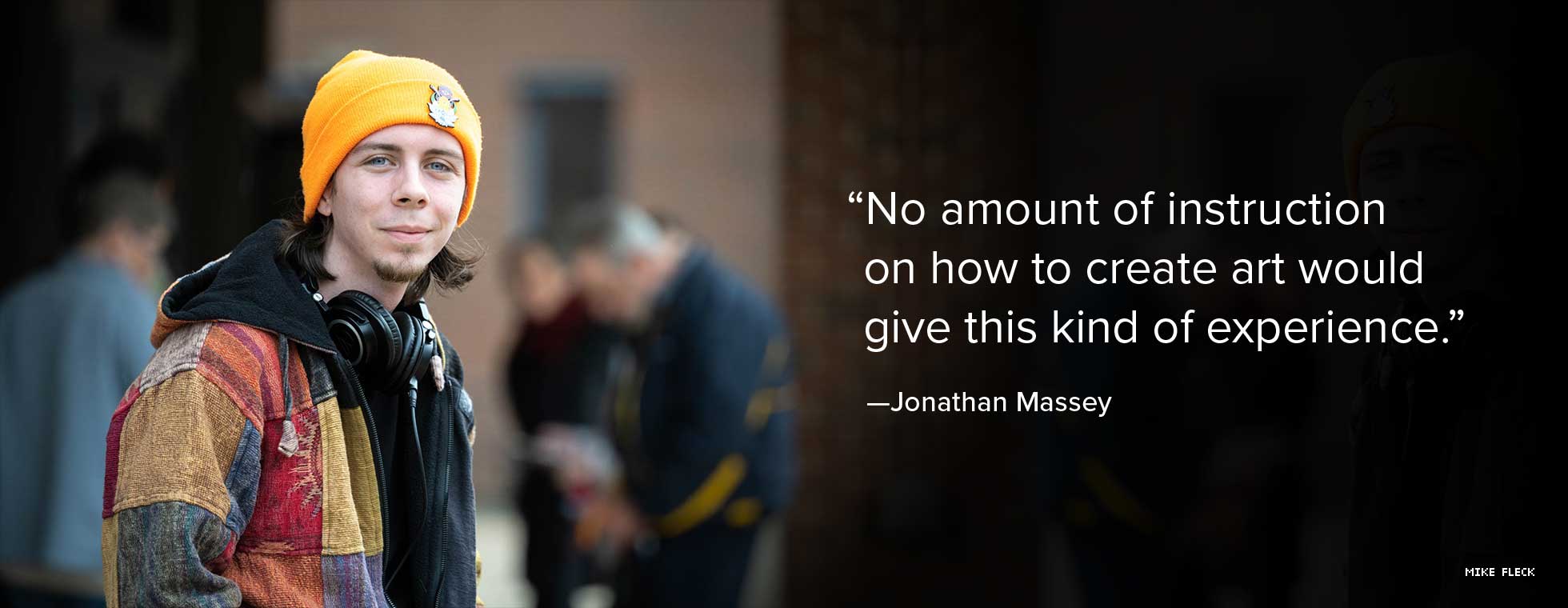Penn State math major gets creative on 200 Acres thought-walk app

Math studies generally leave little room for creativity, but Penn State student Jonathan Massey will graduate in 2024 with an artistic experience that beat the odds. During the spring 2023 semester, he contributed voiceover work to a self-guided walking app created by theater artist Marike Splint and presented by the Center for the Performing Arts.
Splint, a Dutch French-Tunisian University of California-Los Angeles theater instructor and creator, hired Massey to assist her team in producing her self-walk app 200 Acres, a site-specific, self-guided sound experience. The personal experience urges each user to think about “how we shape nature and how nature shapes us,” she said.
200 Acres, a reference to the acreage of land originally granted to Penn State, is a sequel to Splint’s 32 Acres, a similar project highlighting a plot of green space in Los Angeles. The app’s self-guided one-mile tour leads the user on an introspective walking and prompted experience along a route leaving from the patio of Eisenhower Auditorium and ending at The Arboretum at Penn State.
The app and an artist residency, part of the center’s “Reflection Project,” was funded by the Mellon Foundation. The residency saw Splint and a small group of assistants visiting Penn State in the fall of 2022 and again in March to take field recordings and conduct interviews with figures on campus.
Visit 200 Acres online for more information.
Massey said Pitch Exploration Lab Director Bryan Nichols shared an email chain from Splint in search of an assistant, “which led to a voiceover and implementation role in the project.” He called the process “a fortunate coincidence.”
As the 200 Acres script guides the user, Splint’s voiceover provides commentary about buildings and land history — from rich histories of trees and personal reflections on family “togetherness” to the Penn State milking barns and mountainous views.
He said the app’s use of geolocation software drew him to the project, more specifically to “the possibilities of joining theater with game development to create artistic experiences that mimic the tried-and-true video game aspects that make playable stories compelling.”
“His interest in music tech made him a natural fit to help us with the project,” Splint said of Massey’s contributions to the app.
“Very rarely does a college education become as personal as the opportunity I’ve had with 200 Acres,” Massey said. “I’ve been taught various programs like Reaper, FMOD, and Unity, and given insight into the app development process.
“But it has been more valuable to observe the creative process that the team has gone through to complete a project that they are proud to attach their name to.”
“No amount of instruction on how to create art would give this kind of experience. I’ve felt confident in my own artistic ability, even though my major has little indication of creativity. It gives me pride that I’ve been able to accomplish this dream in some way.”
“Those outside the field may see [math and music] as separate," Massey said, “but everyone within the discipline wishes they did more of either. I hear lots of math students looking for creative outlets, especially those which had an interest in music previously. Lots of music people are looking to study physics, computer science, or data science. Data science shows up in the research that I conduct, group theory shows up in music theory, probability shows up in noise generating functions and music synthesis.
“I’ve been repeatedly shown the value of letting otherwise separate fields ‘talk,’ by exchanging ideas and methods for the betterment of both disciplines. It has been my goal to do this with math and music, an area I feel I am academically strong in and an area where my passion lies.”
“The Pitch Exploration Lab is an interdisciplinary music cognition lab which I have been a part of since my freshman year of undergrad. I was told about the lab during an open house I attended during my college search. The lab’s existence interested me enough to come to Penn State, and it has been an asset to my education throughout my time here," Massey said.
“I am currently working on a research project aiming to measure music’s effect on a listener in the context of eight-channel circular speaker arrays. The research uses tasks of auditory imagery, attentional flexibility, working memory and emotional valence. I’ve been reviewing music cognition literature to inform the process and hope to conduct the study in my senior year.”

